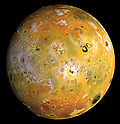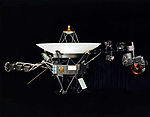- Masubi (volcano)
-
Masubi is an active volcano on Jupiter's moon Io. It is located on Io's leading hemisphere at 49°36′S 56°11′W / 49.6°S 56.18°W[1]Coordinates: 49°36′S 56°11′W / 49.6°S 56.18°W[1] within a bright terrain region named Tarsus Regio. A volcanic plume has been observed at Masubi by various spacecraft starting with Voyager 1 in 1979, though it has not been persistent like similar Ionian volcanoes Amirani and Prometheus.[2] Masubi is also notable for having one of the largest active lava flows on Io, with an additional 240-kilometer flow forming between 1999 and 2007.[3]
Contents
Observations by Voyager 1
The volcano was first observed during the Voyager 1 encounter with the Jupiter system on March 5, 1979. Voyager discovered a 64-kilometer tall, 177-kilometer wide volcanic dust plume, composed primarily of sulfur dioxide, at the northern end of a 501-kilometer long dark lava flow.[4][5] To date, images taken by Voyager 1's Imaging Science Sub-system Wide-Angle Camera shortly before the spacecraft's closest approach to Io have the highest spatial resolution coverage of this volcano at two kilometers per pixel.[6] These images reveal a lava flow with a V-shaped northern end, associated with the plume source as noted by the dark plume deposit ring surrounding it, and bifurcated southern section.[6] The two-lobed shape of the plume deposit may result from the Masubi volcanic plume during Voyager 1 encounter having two sources on the flow field and two eruption columns.[7] This was the faintest of the plumes on Io observed by the two Voyager spacecraft. It was initially designated as Plume 8, but in 1979 the International Astronomical Union formally named it Masubi, after a Japanese fire god called Ho-Masubi.[1] The lava flow associated with the plume was named Masubi Fluctus shortly after the start of the Galileo mission.[8]
Observations by Galileo
The Galileo spacecraft and ground-based astronomers observed volcanic activity at Masubi on several occasions in the late 1990s, but it was not a persistent thermal hotspot.[9] The camera on Galileo observed a volcanic plume along Masubi Fluctus during the Galileo extended missions, in July/August 1999 and August 2001.[2] Galileo's cameras also observed a plume deposit form in September 1997. In each of these cases, the volcanic plumes emanated from different parts of Masubi Fluctus, providing further evidence that dust plumes like the one at Masubi result from the rapid sublimation of surficial sulfur dioxide frost by warm, advancing lava flow fronts, rather than erupting from the primary volcanic vent.[10] Ground-based astronomers in August 1998 briefly observed a high-temperature eruption at Masubi, confirming Masubi Fluctus' silicate mafic to ultramafic composition.[11]
Observations by New Horizons
Masubi was last observed by a spacecraft during New Horizons' February 28, 2007 encounter with the Jupiter system. During this encounter, two plumes were observed along Masubi Fluctus. One was seen at the northern end of the flow, interpreted as the main source vent for the flow. The second was observed near the middle of the elongated flow field.[3] These two plumes were 70 and 80 kilometers tall respectively. New Horizons also observed a fresh, 240-kilometer lava flow at Masubi, which formed between Galileo's last observation of Masubi Fluctus in 1999 and the New Horizons flyby in 2007.[3] This was the largest new lava flow observed anywhere in the solar system since extra-terrestrial volcanism was discovered on Io in 1979.[12] The two plumes observed emanate from the northern and southern ends of this new flow. Fallout from the two volcanic plumes produced a two-lobed dark deposit around the new lava flow, similar to the deposit seen during the Voyager encounters.
New Horizons images also highlighted the fact that the visibility of the older, 500-km long flow varies depending on the phase angle of the observation. Phase angle is the angle between the observer, Io, and the Sun. Io appears "full" at low phase angles near 0°, "half-full" at moderate phase angles near 90°, and crescent shaped at high phase angles approaching 180°. The older portion of Masubi Fluctus is nearly invisible at low phase angles and only shows up at high phase angles.[3] This may be due to sulfur dioxide frost on top of the now cooled lava flow obscuring it, but this deposit is not yet thick enough to obscure the texture of the flow.[3] A similar phase angle effect at Masubi Fluctus was also observed by Voyager and Galileo, though this was limited to longer visible wavelengths.[13]
Gallery
References
- ^ a b Blue, Jennifer. "Masubi". Gazetteer of Planetary Nomenclature. USGS Astrogeology Research Program.
- ^ a b Geissler, P. E.; M. T. McMillan (2008). "Galileo observations of volcanic plumes on Io". Icarus 197 (2): 505–18. Bibcode 2008Icar..197..505G. doi:10.1016/j.icarus.2008.05.005.
- ^ a b c d e Spencer, J. R.; et al. (2007). "Io Volcanism Seen by New Horizons: A Major Eruption of the Tvashtar Volcano". Science 318 (5848): 240–43. Bibcode 2007Sci...318..240S. doi:10.1126/science.1147621. PMID 17932290.
- ^ Davies, Ashley (2007). "Io, 1610-1979". Volcanism on Io: A Comparison with Earth. Cambridge University Press. pp. 7–26. ISBN 0-521-85003-7.
- ^ Strom, R. G.; et al. (1979). "Volcanic eruption plumes on Io". Nature 280 (5725): 733–736. Bibcode 1979Natur.280..733S. doi:10.1038/280733a0.
- ^ a b Perry, Jason (March 9, 2009). "Taking another look at Voyager 1 images of Io". The Gish Bar Times. http://gishbar.blogspot.com/2009/03/taking-another-look-at-voyager-1-images.html. Retrieved 2010-01-30.
- ^ Perry, Jason (March 8, 2009). "30th Anniversary of the Discovery of Volcanism on Io". The Gish Bar Times. http://gishbar.blogspot.com/2009/03/30th-anniversary-of-discovery-of.html. Retrieved 2010-01-30.
- ^ Blue, Jennifer. "Masubi Fluctus". Gazetteer of Planetary Nomenclature. USGS Astrogeology Research Program.
- ^ Lopes, R. M. C.; et al. (2001). "Io in the near infrared: Near-Infrared Mapping Spectrometer (NIMS) results from the Galileo flybys in 1999 and 2000". Journal of Geophysical Research 106 (E12): 33,053–33,078. Bibcode 2001JGR...10633053L. doi:10.1029/2000JE001463.
- ^ Phillips, Cynthia (October 7, 1999). "Migrating Volcanic Plumes on Io". Planetary Image Research Laboratory. https://pirlwww.lpl.arizona.edu/wiki/missions/Galileo/releases/7Oct_masubichanges. Retrieved 2010-01-30.
- ^ Geissler, Paul (2003). "Volcanic Activity on Io During the Galileo Era". Annu. Rev. Earth Sci. 31: 175–211. Bibcode 2003AREPS..31..175G. doi:10.1146/annurev.earth.31.100901.145428.
- ^ "Changes on Io". New Horizons: NASA's Pluto-Kuiper Belt Mission. October 9, 2007. http://pluto.jhuapl.edu/gallery/sciencePhotos/image.php?page=1&gallery_id=2&image_id=62. Retrieved 2010-01-30.
- ^ Simonelli, D. P.; et al. (2001). "Regolith Variations on Io: Implications for bolometric albedos". Journal of Geophysical Research 106 (E12): 33,241–33,252. Bibcode 2001JGR...10633241S. doi:10.1029/2000JE001350.
Main articles 
Lists Paterae Mountains Lava Flows or Channels TawhakiVolcanoes Exploration Pioneer program · Voyager program · Galileo · Cassini · New Horizons · Juno · Europa Jupiter System Mission · Io Volcano Observer (proposed)Voyager program Concepts 
Voyager 1 Work- Pale Blue Dot
- Family Portrait (Voyager)
- Voyager Golden Record
- Contents of the Voyager Golden Record
- Voyager: Sounds of the Cosmos
Voyager 2 Work- Voyager Golden Record
- Contents of the Voyager Golden Record
- Voyager: Sounds of the Cosmos
Voyager team - Stamatios Krimigis
- Carolyn Porco
- Raymond Heacock
- Jim Blinn
- Edward C. Stone
- Timothy Ferris
Observations Categories:- Volcanoes of Io
Wikimedia Foundation. 2010.



